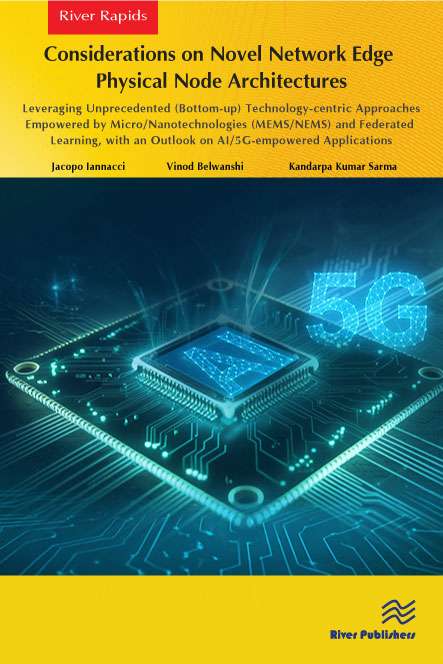
Considerations on Novel Network Edge Physical Node Architectures
Leveraging Unprecedented (Bottom-up) Technology-centric Approaches Empowered by Micro/Nanotechnologies (MEMS/NEMS) and Federated Learning, with an Outlook on AI/5G-empowered Applications
Computer Engineering and Information Science and Technology
Considerations on Novel Network Edge Physical Node Architectures
Leveraging Unprecedented (Bottom-up) Technology-centric Approaches Empowered by Micro/Nanotechnologies (MEMS/NEMS) and Federated Learning, with an Outlook on AI/5G-empowered Applications Forthcoming
Editors:
Jacopo Iannacci, Fondazione Bruno Kessler (FBK), Italy
Vinod Belwanshi, CSIR - National Metallurgical Laboratory, India
Kandarpa Kumar Sarma, Gauhati University, India
ISBN: 9788743809180 e-ISBN: 9788743809173
Available: January 2026
The relentless pace of technological advancement, particularly in telecommunications, is reshaping how we connect and communicate. What once took a decade to standardize now evolves in just a few years, blurring generational divides and delivering seamless transitions to users. Against this backdrop, Considerations on Novel Network Edge Physical Node Architectures explores the complex paradigm of 6G mobile communications—anticipated to emerge around 2030—and casts a longer-term vision toward future networks (FNs).
The scientific community has been engaged in 6G research since 2017–2018, defining use cases, key enabling technologies (KETs), and performance indicators (KPIs). Ambitious targets include peak data rates of 1 Tbps, average user rates of 10–100 Gbps, sub-0.1 ms latency, and reliability greater than 10⁻⁸. Application domains span holographic communications, digital twins, multi-sensory extended reality (XR), tactile and haptic interactions, and integrated space–terrestrial networks.
While these expectations hold the promise of a more interconnected world, realizing them demands a fundamental shift in approach. The projected density of 10–100 million smart devices per square kilometer in 6G networks cannot be addressed through conventional hardware–software co-design alone. This book proposes new ways of conceiving the physical building blocks of edge intelligence (EI), where intelligence is embedded at the network’s edge.
Central to this vision is the use of micro- and nanotechnologies (MEMS/NEMS) to create miniaturized sensors, actuators, and transducers (SATs) that serve as distributed intelligence units. These physical innovations are examined alongside non-physical enablers such as artificial intelligence (AI) and federated learning (FL), illustrating how a holistic integration of technologies can enable practical, scalable applications.
By bridging physical and digital innovations, Considerations on Novel Network Edge Physical Node Architectures aims to inject fresh ideas into scientific discourse and provide a foundation for turning the ambitious visions of 6G and future networks into reality. It is an essential resource for researchers, engineers, and industry professionals seeking to shape the next generation of telecommunications infrastructure.
- Considerations on Transformative Needs at the Edge of 6G and of Future Networks
- Micro and Nanotechnologies as a Key Enabling Technology of the Future Network Edge
- Micro/Nano Fabrication Processes: Utilizing Borrowed and Dedicated Fabrication Processes for 6G and Future Network Devices
- Federated Multi-agent Reinforcement Learning for Edge-intelligent Beamforming Codebook Design for mmWave MIMO
- Advancements in Cardiac Monitoring: The Role of AI and 5G Networks in Optimizing Cardiovascular Healthcare